Intercomparison of Same-Day Remote Sensing Data for Measuring Winter Cover Crop Biophysical Traits
Abstract
:1. Introduction
2. Materials and Methods
2.1. Study Site and Design
2.2. Sensors
2.2.1. Landsat 7
2.2.2. SPOT 5 and WorldView-2
2.2.3. CROPSCAN
2.2.4. Crop Circle
2.2.5. RGB Photography and Destructive Biomass Samples
2.3. Growing Degree Days
2.4. Statistical Analysis for Sensor Intercomparison
3. Results
3.1. Reflectance Comparisons of Satellite and Proximal Sensors
3.2. Relation of Satellite Processing Level and Proximal Sensors
3.3. Sensor Intercomparisons of Cover Crop Biophysical Traits
4. Discussion
5. Conclusions
Supplementary Materials
Author Contributions
Funding
Institutional Review Board Statement
Informed Consent Statement
Data Availability Statement
Acknowledgments
Conflicts of Interest
References
- Maryland Department of Agriculture. MACS 2017 Annual Report; Maryland Department of Agriculture: Annapolis, MD, USA, 2017.
- Hively, W.D.; Lee, S.; Sadeghi, A.M.; McCarty, G.W.; Lamb, B.T.; Soroka, A.; Keppler, J.; Yeo, I.-Y.; Moglen, G.E. Estimating the Effect of Winter Cover Crops on Nitrogen Leaching Using Cost-Share Enrollment Data, Satellite Remote Sensing, and Soil and Water Assessment Tool (SWAT) Modeling. J. Soil Water Conserv. 2020, 75, 362–375. [Google Scholar] [CrossRef]
- Meisinger, J.J.; Hargrove, W.L.; Mikkelsen, R.L.; Williams, J.R.; Benson, V.W. Effects of Cover Crops on Groundwater Quality. Cover Crop. Clean Water Soil Water Conserv. Soc. Ankeny Iowa 1991, 266, 793–799. [Google Scholar]
- Dabney, S.M.; Delgado, J.A.; Reeves, D.W. Using Winter Cover Crops to Improve Soil and Water Quality. Commun. Soil Sci. Plant Anal. 2001, 32, 1221–1250. [Google Scholar] [CrossRef]
- Jian, J.; Du, X.; Reiter, M.S.; Stewart, R.D. A Meta-Analysis of Global Cropland Soil Carbon Changes Due to Cover Cropping. Soil Biol. Biochem. 2020, 143, 107735. [Google Scholar] [CrossRef]
- Poeplau, C.; Don, A. Carbon Sequestration in Agricultural Soils via Cultivation of Cover Crops–A Meta-Analysis. Agric. Ecosyst. Environ. 2015, 200, 33–41. [Google Scholar] [CrossRef]
- Muhammad, I.; Sainju, U.M.; Zhao, F.; Khan, A.; Ghimire, R.; Fu, X.; Wang, J. Regulation of Soil CO2 and N2O Emissions by Cover Crops: A Meta-Analysis. Soil Tillage Res. 2019, 192, 103–112. [Google Scholar] [CrossRef]
- Ator, S.W.; Denver, J.M. Understanding the Nutrients in the Chesapeake Bay Watershed and Implications for Management and Restoration: The Eastern Shore; Circular 1406; U.S. Geological Survey: Reston, VA, USA, 2015; 72 p. [CrossRef]
- Dauer, D.M.; Ranasinghe, J.A.; Weisberg, S.B. Relationships between Benthic Community Condition, Water Quality, Sediment Quality, Nutrient Loads, and Land Use Patterns in Chesapeake Bay. Estuaries 2000, 23, 80–96. [Google Scholar] [CrossRef]
- Talberth, J.; Selman, M.; Walker, S.; Gray, E. Pay for Performance: Optimizing Public Investments in Agricultural Best Management Practices in the Chesapeake Bay Watershed. Ecol. Econ. 2015, 118, 252–261. [Google Scholar] [CrossRef]
- USDA NRCS. Environmental Quality Incentives Program (EQIP) Fact Sheet; 2019. Available online: https://www.nrcs.usda.gov/sites/default/files/2022-10/EQIP-fact-sheet.pdf (accessed on 1 October 2023).
- Bowman, M.; Lynch, L. Government Programs That Support Farmer Adoption of Soil Health Practices. Choices 2019, 34, 1–8. [Google Scholar]
- Wallander, S.; Smith, D.; Bowman, M.; Claassen, R. Cover Crop Trends, Programs, and Practices in the United States; Economic Information Bulletin 222; U.S. Department of Agriculture Economic Research Service: Washington, DC, USA, 2021; p. 33. [CrossRef]
- Goffart, D.; Curnel, Y.; Planchon, V.; Goffart, J.-P.; Defourny, P. Field-Scale Assessment of Belgian Winter Cover Crops Biomass Based on Sentinel-2 Data. Eur. J. Agron. 2021, 126, 126278. [Google Scholar] [CrossRef]
- Hively, W.D.; Lang, M.; McCarty, G.W.; Keppler, J.; Sadeghi, A.; McConnell, L.L. Using Satellite Remote Sensing to Estimate Winter Cover Crop Nutrient Uptake Efficiency. J. Soil Water Conserv. 2009, 64, 303–313. [Google Scholar] [CrossRef]
- Jennewein, J.; Lamb, B.T.; Hively, W.D.; Thieme, A.; Thapa, R.; Goldsmith, A.; Mirsky, S.B. Integration of Satellite-Based Optical and Synthetic Aperture Radar Imagery to Estimate Winter Cover Crop Performance in Cereal Grasses. Remote Sens. 2022, 14, 2077. [Google Scholar] [CrossRef]
- Prabhakara, K.; Hively, W.D.; McCarty, G.W. Evaluating the Relationship between Biomass, Percent Groundcover and Remote Sensing Indices across Six Winter Cover Crop Fields in Maryland, United States. Int. J. Appl. Earth Obs. Geoinf. 2015, 39, 88–102. [Google Scholar] [CrossRef]
- Thieme, A.; Yadav, S.; Oddo, P.C.; Fitz, J.M.; McCartney, S.; King, L.; Keppler, J.; McCarty, G.W.; Hively, W.D. Using NASA Earth Observations and Google Earth Engine to Map Winter Cover Crop Conservation Performance in the Chesapeake Bay Watershed. Remote Sens. Environ. 2020, 248, 111943. [Google Scholar] [CrossRef]
- Thieme, A. Multispectral Satellite Remote Sensing Approaches for Estimating Cover Crop Performance in Maryland and Delaware. Ph.D. Thesis, University of Maryland, College Park, MD, USA, 2022. [Google Scholar]
- Xu, M.; Lacey, C.G.; Armstrong, S.D. The Feasibility of Satellite Remote Sensing and Spatial Interpolation to Estimate Cover Crop Biomass and Nitrogen Uptake in a Small Watershed. J. Soil Water Conserv. 2018, 73, 682–692. [Google Scholar] [CrossRef]
- Prabhakara, K. Factors Influencing Remote Sensing Measurements of Winter Cover Crops. Ph.D. Thesis, University of Maryland, College Park, MD, USA, 2016. Available online: http://hdl.handle.net/1903/18970 (accessed on 16 January 2024).
- Yuan, M.; Burjel, J.C.; Isermann, J.; Goeser, N.J.; Pittelkow, C.M. Unmanned Aerial Vehicle–Based Assessment of Cover Crop Biomass and Nitrogen Uptake Variability. J. Soil Water Conserv. 2019, 74, 350–359. [Google Scholar] [CrossRef]
- USDA NASS. Quick Stats Database; 2022. Available online: https://www.nass.usda.gov/Quick_Stats/ (accessed on 5 October 2023).
- Zhu, Z.; Woodcock, C.E. Object-Based Cloud and Cloud Shadow Detection in Landsat Imagery. Remote Sens. Environ. 2012, 118, 83–94. [Google Scholar] [CrossRef]
- Skakun, S.; Wevers, J.; Brockmann, C.; Doxani, G.; Aleksandrov, M.; Batič, M.; Frantz, D.; Gascon, F.; Gómez-Chova, L.; Hagolle, O. Cloud Mask Intercomparison eXercise (CMIX): An Evaluation of Cloud Masking Algorithms for Landsat 8 and Sentinel-2. Remote Sens. Environ. 2022, 274, 112990. [Google Scholar] [CrossRef]
- Gebbers, R.; Adamchuk, V.I. Precision Agriculture and Food Security. Science 2010, 327, 828–831. [Google Scholar] [CrossRef] [PubMed]
- Hedley, C. The Role of Precision Agriculture for Improved Nutrient Management on Farms. J. Sci. Food Agric. 2015, 95, 12–19. [Google Scholar] [CrossRef] [PubMed]
- Mulla, D.J. Twenty Five Years of Remote Sensing in Precision Agriculture: Key Advances and Remaining Knowledge Gaps. Biosyst. Eng. 2013, 114, 358–371. [Google Scholar] [CrossRef]
- Pittman, J.J.; Arnall, D.B.; Interrante, S.M.; Moffet, C.A.; Butler, T.J. Estimation of Biomass and Canopy Height in Bermudagrass, Alfalfa, and Wheat Using Ultrasonic, Laser, and Spectral Sensors. Sensors 2015, 15, 2920–2943. [Google Scholar] [CrossRef]
- Holland Scientific. Forage Sensor Box. Precision Sustainable Agriculture. Available online: https://www.precisionsustainableag.org/forage-sensor-box (accessed on 10 May 2023).
- Dong, T.; Liu, J.; Qian, B.; He, L.; Liu, J.; Wang, R.; Jing, Q.; Champagne, C.; McNairn, H.; Powers, J.; et al. Estimating Crop Biomass Using Leaf Area Index Derived from Landsat 8 and Sentinel-2 Data. ISPRS J. Photogramm. Remote Sens. 2020, 168, 236–250. [Google Scholar] [CrossRef]
- Dehghan-Shoar, M.H.; Pullanagari, R.R.; Kereszturi, G.; Orsi, A.A.; Yule, I.J.; Hanly, J. A Unified Physically Based Method for Monitoring Grassland Nitrogen Concentration with Landsat 7, Landsat 8, and Sentinel-2 Satellite Data. Remote Sens. 2023, 15, 2491. [Google Scholar] [CrossRef]
- Mandanici, E.; Bitelli, G. Preliminary Comparison of Sentinel-2 and Landsat 8 Imagery for a Combined Use. Remote Sens. 2016, 8, 1014. [Google Scholar] [CrossRef]
- Erdle, K.; Mistele, B.; Schmidhalter, U. Comparison of Active and Passive Spectral Sensors in Discriminating Biomass Parameters and Nitrogen Status in Wheat Cultivars. Field Crop. Res. 2011, 124, 74–84. [Google Scholar] [CrossRef]
- Fitzgerald, G.J. Characterizing Vegetation Indices Derived from Active and Passive Sensors. Int. J. Remote Sens. 2010, 31, 4335–4348. [Google Scholar] [CrossRef]
- Prudente, V.H.R.; Mercante, E.; Johann, J.A.; Souza, C.H.W.D.; Oldoni, L.V.; Almeida, L.; Becker, W.R.; Da Silva, B.B. Comparison between Vegetation Index Obtained by Active and Passive Proximal Sensors. J. Agric. Stud. 2022, 9, 391. [Google Scholar] [CrossRef]
- Yao, X.; Yao, X.; Jia, W.; Tian, Y.; Ni, J.; Cao, W.; Zhu, Y. Comparison and Intercalibration of Vegetation Indices from Different Sensors for Monitoring Above-Ground Plant Nitrogen Uptake in Winter Wheat. Sensors 2013, 13, 3109–3130. [Google Scholar] [CrossRef] [PubMed]
- Winterhalter, L.; Mistele, B.; Schmidhalter, U. Evaluation of Active and Passive Sensor Systems in the Field to Phenotype Maize Hybrids with High-Throughput. Field Crop. Res. 2013, 154, 236–245. [Google Scholar] [CrossRef]
- Biney, J.K.M.; Saberioon, M.; Borůvka, L.; Houška, J.; Vašát, R.; Chapman Agyeman, P.; Coblinski, J.A.; Klement, A. Exploring the Suitability of Uas-Based Multispectral Images for Estimating Soil Organic Carbon: Comparison with Proximal Soil Sensing and Spaceborne Imagery. Remote Sens. 2021, 13, 308. [Google Scholar] [CrossRef]
- Wijesingha, J.; Dayananda, S.; Wachendorf, M.; Astor, T. Comparison of Spaceborne and Uav-Borne Remote Sensing Spectral Data for Estimating Monsoon Crop Vegetation Parameters. Sensors 2021, 21, 2886. [Google Scholar] [CrossRef] [PubMed]
- Doraiswamy, P.C.; Hatfield, J.L.; Jackson, T.J.; Akhmedov, B.; Prueger, J.; Stern, A. Crop Condition and Yield Simulations Using Landsat and MODIS. Remote Sens. Environ. 2004, 92, 548–559. [Google Scholar] [CrossRef]
- Moravec, D.; Komárek, J.; López-Cuervo Medina, S.; Molina, I. Effect of Atmospheric Corrections on NDVI: Intercomparability of Landsat 8, Sentinel-2, and UAV Sensors. Remote Sens. 2021, 13, 3550. [Google Scholar] [CrossRef]
- Pancorbo, J.L.; Lamb, B.T.; Quemada, M.; Hively, W.D.; Gonzalez-Fernandez, I.; Molina, I. Sentinel-2 and WorldView-3 Atmospheric Correction and Signal Normalization Based on Ground-Truth Spectroradiometric Measurements. ISPRS J. Photogramm. Remote Sens. 2021, 173, 166–180. [Google Scholar] [CrossRef]
- CROPSCAN, Inc. CROPSCAN. 2013. Available online: http://www.cropscan.com/ (accessed on 17 September 2023).
- Holland Scientific. Crop Circle ACS-470 Multi-Spectral Crop Canopy Sensor. Available online: http://hollandscientific.com/crop-circle-acs-470-multi-spectral-crop-canopy-sensor/ (accessed on 10 May 2023).
- Holben, B. AERONET. 1993. Available online: http://aeronet.gsfc.nasa.gov/ (accessed on 5 September 2023).
- USGS ESPA. EROS Science Processing Architecture. EROS Science Processing Architecture On Demand Interface. Available online: https://espa.cr.usgs.gov/ (accessed on 4 August 2023).
- Masek, J.G.; Vermote, E.F.; Saleous, N.E.; Wolfe, R.; Hall, F.G.; Huemmrich, K.F.; Gao, F.; Kutler, J.; Lim, T.-K. A Landsat Surface Reflectance Dataset for North America, 1990–2000. IEEE Geosci. Remote Sens. Lett. 2006, 3, 68–72. [Google Scholar] [CrossRef]
- U.S. Geological Survey. EarthExplorer. 2024. Available online: https://earthexplorer.usgs.gov/ (accessed on 4 February 2024).
- USGS. Landsat 7 SLC-Off Products. Landsat 7 SLC-Off Products. Available online: https://www.usgs.gov/landsat-missions/landsat-7 (accessed on 4 August 2023).
- Huang, C.; Thomas, N.; Goward, S.N.; Masek, J.G.; Zhu, Z.; Townshend, J.R.G.; Vogelmann, J.E. Automated Masking of Cloud and Cloud Shadow for Forest Change Analysis Using Landsat Images. Int. J. Remote Sens. 2010, 31, 5449–5464. [Google Scholar] [CrossRef]
- NV5 Geospatial Software. Exelis Visual Information Solutions, ENVI. V. 4.8; NV5 Geospatial Software: Herndon, VA, USA, 2012. [Google Scholar]
- Berk, A.; Conforti, P.; Kennett, R.; Perkins, T.; Hawes, F.; van den Bosch, J. MODTRAN® 6: A Major Upgrade of the MODTRAN® Radiative Transfer Code. In Proceedings of the 2014 6th Workshop on Hyperspectral Image and Signal Processing: Evolution in Remote Sensing (WHISPERS), Lausanne, Switzerland, 24–27 June 2014; pp. 1–4. [Google Scholar] [CrossRef]
- Spectral Sciences Inc. MODTRAN5. 2012. Available online: http://modtran5.com/ (accessed on 4 September 2023).
- Lamb, B.T.; Hively, W.D.; Jennewein, J.; Thieme, A.; Soroka, A. Atmospheric Correction Intercomparison of Hyperspectral and Multispectral Imagery over Agricultural Study Sites; IEEE: Pasadena, CA, USA, 2023. [Google Scholar]
- Kotchenova, S.Y.; Vermote, E.F.; Levy, R.; Lyapustin, A. Radiative Transfer Codes for Atmospheric Correction and Aerosol Retrieval: Intercomparison Study. Appl. Opt. 2008, 47, 2215–2226. [Google Scholar] [CrossRef] [PubMed]
- Vermote, E.F.; Tanré, D.; Deuze, J.L.; Herman, M.; Morcette, J.-J. Second Simulation of the Satellite Signal in the Solar Spectrum, 6S: An Overview. IEEE Trans. Geosci. Remote Sens. 1997, 35, 675–686. [Google Scholar] [CrossRef]
- Environment Canada. Ozone Map Archive. 2016. Available online: http://exp-studies.tor.ec.gc.ca/cgi-bin/clf2/selectMap?lang=e&printerversion=false&printfullpage=false&accessible=off/ (accessed on 16 March 2023).
- NOAA ERSL. Radiosonde Database. 2016. Available online: http://www.esrl.noaa.gov/raobs/ (accessed on 16 March 2023).
- Oliveira, L.F.; Scharf, P.C. Diurnal Variability in Reflectance Measurements from Cotton. Crop. Sci. 2014, 54, 1769–1781. [Google Scholar] [CrossRef]
- Darra, N.; Psomiadis, E.; Kasimati, A.; Anastasiou, A.; Anastasiou, E.; Fountas, S. Remote and Proximal Sensing-Derived Spectral Indices and Biophysical Variables for Spatial Variation Determination in Vineyards. Agronomy 2021, 11, 741. [Google Scholar] [CrossRef]
- Devadas, R. Analysis of the Interaction of Nitrogen Application and Stripe Rust Infection in Wheat Using in Situ Proximal and Remote Sensing Techniques; School of Science and Technology, University of New England: Armidale, Australia, 2009. [Google Scholar]
- Kipp, S.; Mistele, B.; Schmidhalter, U. The Performance of Active Spectral Reflectance Sensors as Influenced by Measuring Distance, Device Temperature and Light Intensity. Comput. Electron. Agric. 2014, 100, 24–33. [Google Scholar] [CrossRef]
- Booth, D.T.; Cox, S.E.; Berryman, R.D. Point Sampling Digital Imagery with ‘Samplepoint’. Environ. Monit. Assess. 2006, 123, 97–108. [Google Scholar] [CrossRef] [PubMed]
- Cosh, M.H.; Tao, J.; Jackson, T.J.; McKee, L.; O’Neill, P.E. Vegetation Water Content Mapping in a Diverse Agricultural Landscape: National Airborne Field Experiment 2006. J. Appl. Remote Sens. 2010, 4, 043532. [Google Scholar]
- Tucker, C.J. Red and Photographic Infrared Linear Combinations for Monitoring Vegetation. Remote Sens. Environ. 1979, 8, 127–150. [Google Scholar] [CrossRef]
- Huete, A.; Didan, K.; Miura, T.; Rodriguez, E.P.; Gao, X.; Ferreira, L.G. Overview of the Radiometric and Biophysical Performance of the MODIS Vegetation Indices. Remote Sens. Environ. 2002, 83, 195–213. [Google Scholar] [CrossRef]
- Gao, S.; Zhong, R.; Yan, K.; Ma, X.; Chen, X.; Pu, J.; Gao, S.; Qi, J.; Yin, G.; Myneni, R.B. Evaluating the Saturation Effect of Vegetation Indices in Forests Using 3D Radiative Transfer Simulations and Satellite Observations. Remote Sens. Environ. 2023, 295, 113665. [Google Scholar] [CrossRef]
- Gitelson, A.A.; Stark, R.; Grits, U.; Rundquist, D.; Kaufman, Y.; Derry, D. Vegetation and Soil Lines in Visible Spectral Space: A Concept and Technique for Remote Estimation of Vegetation Fraction. Int. J. Remote Sens. 2002, 23, 2537–2562. [Google Scholar] [CrossRef]
- Jiang, Z.; Huete, A.R.; Didan, K.; Miura, T. Development of a Two-Band Enhanced Vegetation Index without a Blue Band. Remote Sens. Environ. 2008, 112, 3833–3845. [Google Scholar] [CrossRef]
- R Core Team. R: A Language and Environment for Statistical Computing. R Foundation for Statistical Computing. 2016. Available online: https://www.R-project.org/ (accessed on 16 March 2023).
- Lenth, R.; Singmann, H.; Love, J.; Buerkner, P.; Herve, M. Package ‘Emmeans’. R Package Version 2019, 1. [Google Scholar] [CrossRef]
- Trishchenko, A.P.; Cihlar, J.; Li, Z. Effects of Spectral Response Function on Surface Reflectance and NDVI Measured with Moderate Resolution Satellite Sensors. Remote Sens. Environ. 2002, 81, 1–18. [Google Scholar] [CrossRef]
- Gong, P.; Pu, R.; Heald, R.C. Analysis of in Situ Hyperspectral Data for Nutrient Estimation of Giant Sequoia. Int. J. Remote Sens. 2002, 23, 1827–1850. [Google Scholar] [CrossRef]
- Horler, D.N.H.; Dockray, M.; Barber, J. The Red Edge of Plant Leaf Reflectance. Int. J. Remote Sens. 1983, 4, 273–288. [Google Scholar] [CrossRef]
- Thieme, A.; Hively, W.D.; Gao, F.; Jennewein, J.; Mirsky, S.; Soroka, A.; Keppler, J.; Bradley, D.; Skakun, S.; McCarty, G.W. Remote Sensing Evaluation of Winter Cover Crop Springtime Performance and the Impact of Delayed Termination. Agron. J. 2023, 115, 442–458. [Google Scholar] [CrossRef]
- Zhu, Z.; Wang, S.; Woodcock, C.E. Improvement and Expansion of the Fmask Algorithm: Cloud, Cloud Shadow, and Snow Detection for Landsats 4–7, 8, and Sentinel 2 Images. Remote Sens. Environ. 2015, 159, 269–277. [Google Scholar] [CrossRef]
- Vermote, E.; Justice, C.; Claverie, M.; Franch, B. Preliminary Analysis of the Performance of the Landsat 8/OLI Land Surface Reflectance Product. Remote Sens. Environ. 2016, 185, 46–56. [Google Scholar] [CrossRef] [PubMed]
- Skakun, S.; Vermote, E.F.; Artigas, A.E.S.; Rountree, W.H.; Roger, J.-C. An Experimental Sky-Image-Derived Cloud Validation Dataset for Sentinel-2 and Landsat 8 Satellites over NASA GSFC. Int. J. Appl. Earth Obs. Geoinform. 2021, 95, 102253. [Google Scholar] [CrossRef]
- Simpson, J.J.; Stitt, J.R. A Procedure for the Detection and Removal of Cloud Shadow from AVHRR Data over Land. IEEE Trans. Geosci. Remote Sens. 1998, 36, 880–897. [Google Scholar] [CrossRef]
- Holden, C.E.; Woodcock, C.E. An Analysis of Landsat 7 and Landsat 8 Underflight Data and the Implications for Time Series Investigations. Remote Sens. Environ. 2016, 185, 16–36. [Google Scholar] [CrossRef]
- Skakun, S.; Vermote, E.; Roger, J.-C.; Justice, C. Multispectral Misregistration of Sentinel-2A Images: Analysis and Implications for Potential Applications. IEEE Geosci. Remote Sens. Lett. 2017, 14, 2408–2412. [Google Scholar] [CrossRef] [PubMed]
- Kaufman, Y.J.; Tanré, D.; Holben, B.N.; Markham, B.L.; Gitelson, A.A. Atmospheric Effects on the NDVI–Strategies for Its Removal. In School of Natural Resources: Faculty Publications; IEEE: Piscataway, NJ, USA, 1992. [Google Scholar]
- Thompson, D.R.; Gao, B.-C.; Green, R.O.; Roberts, D.A.; Dennison, P.E.; Lundeen, S.R. Atmospheric Correction for Global Mapping Spectroscopy: ATREM Advances for the HyspIRI Preparatory Campaign. Remote Sens. Environ. 2015, 167, 64–77. [Google Scholar] [CrossRef]
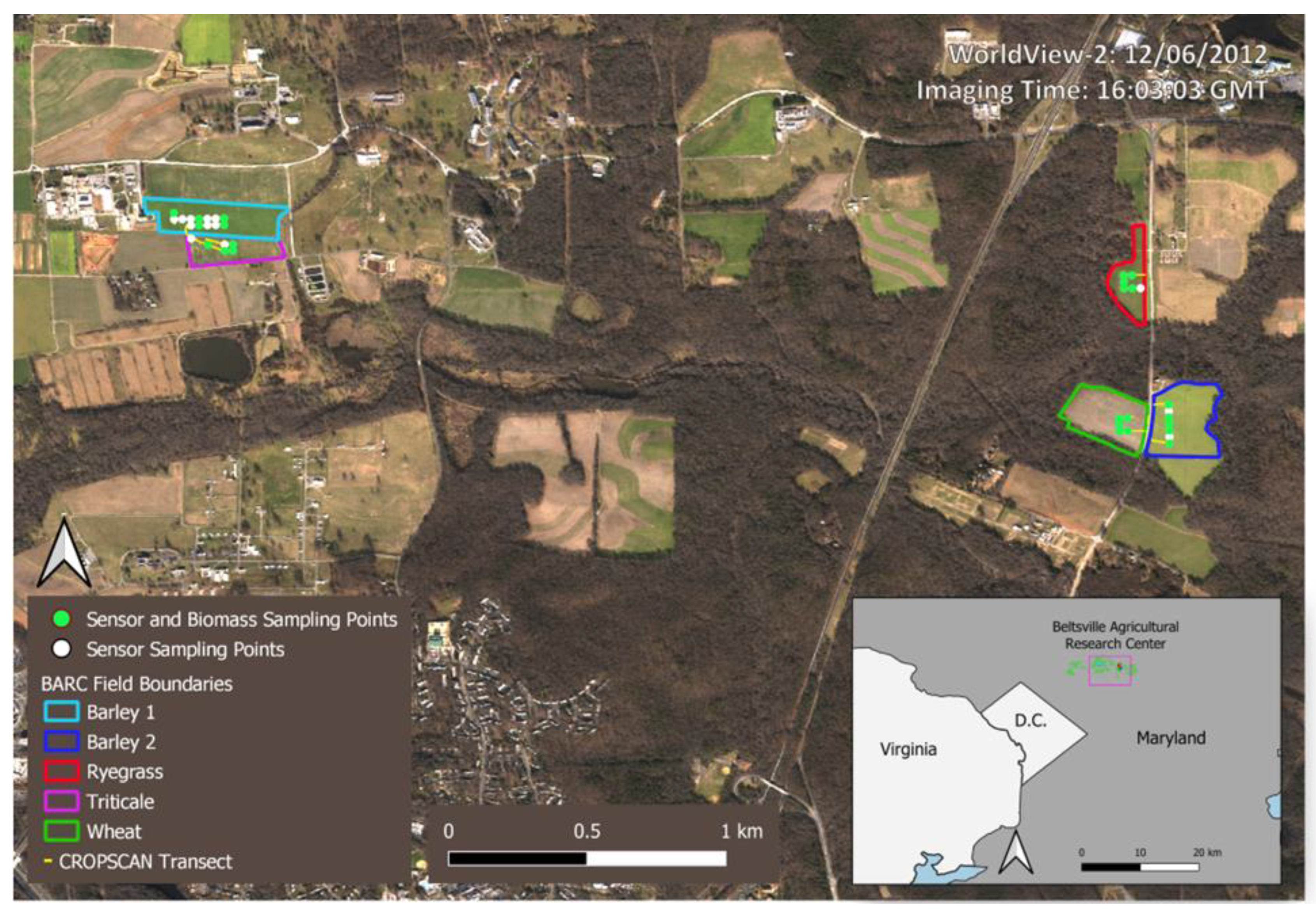
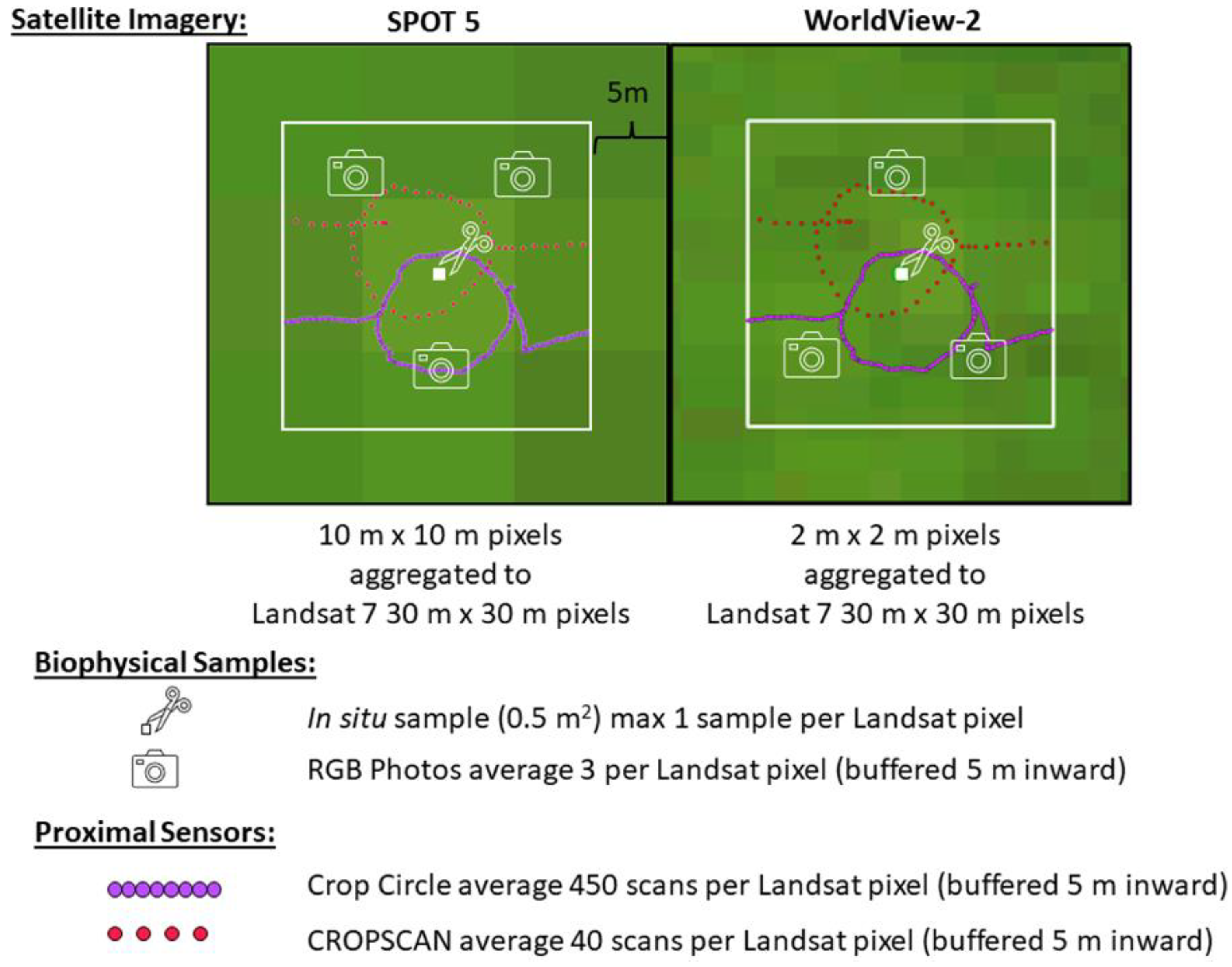


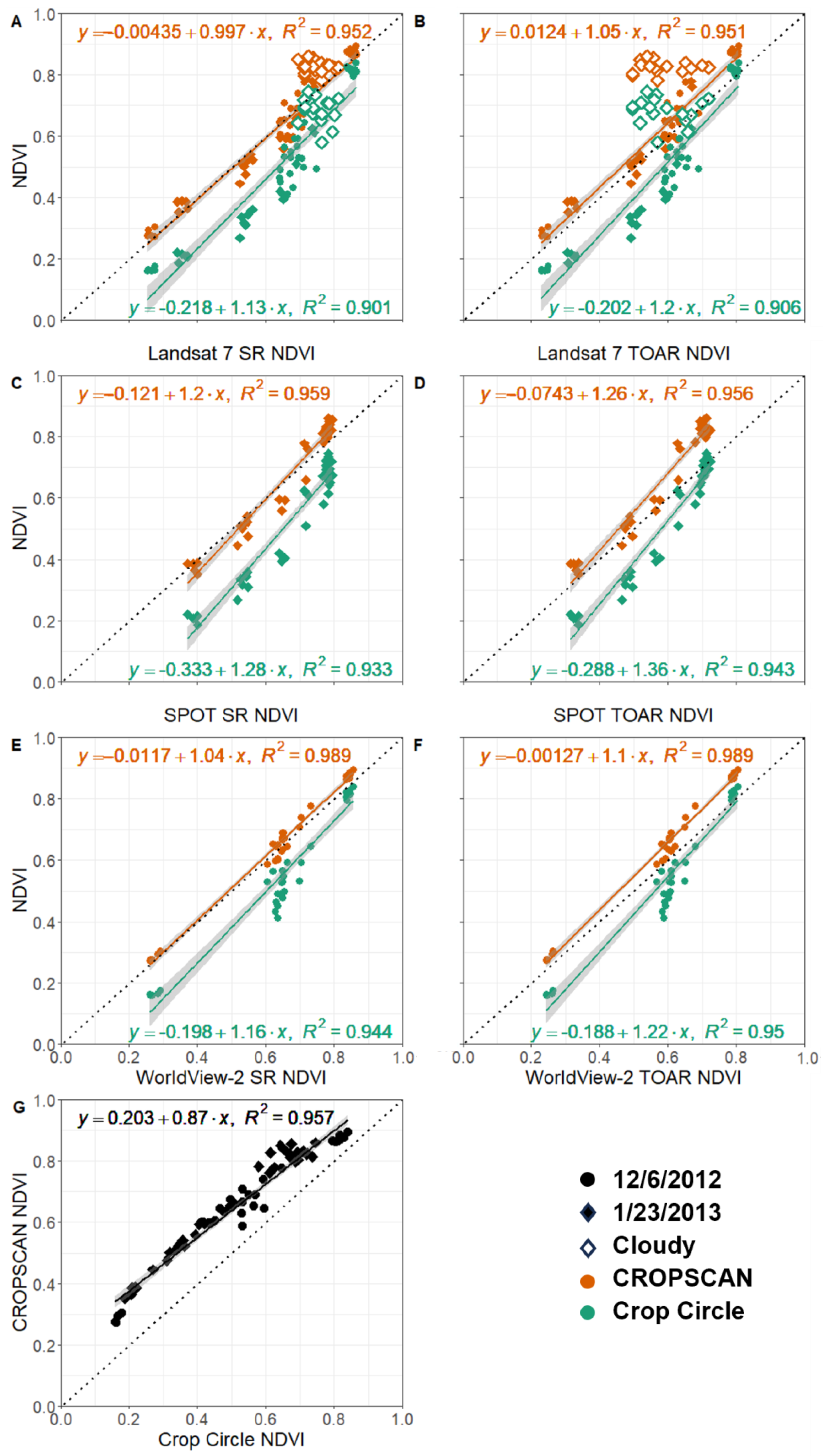
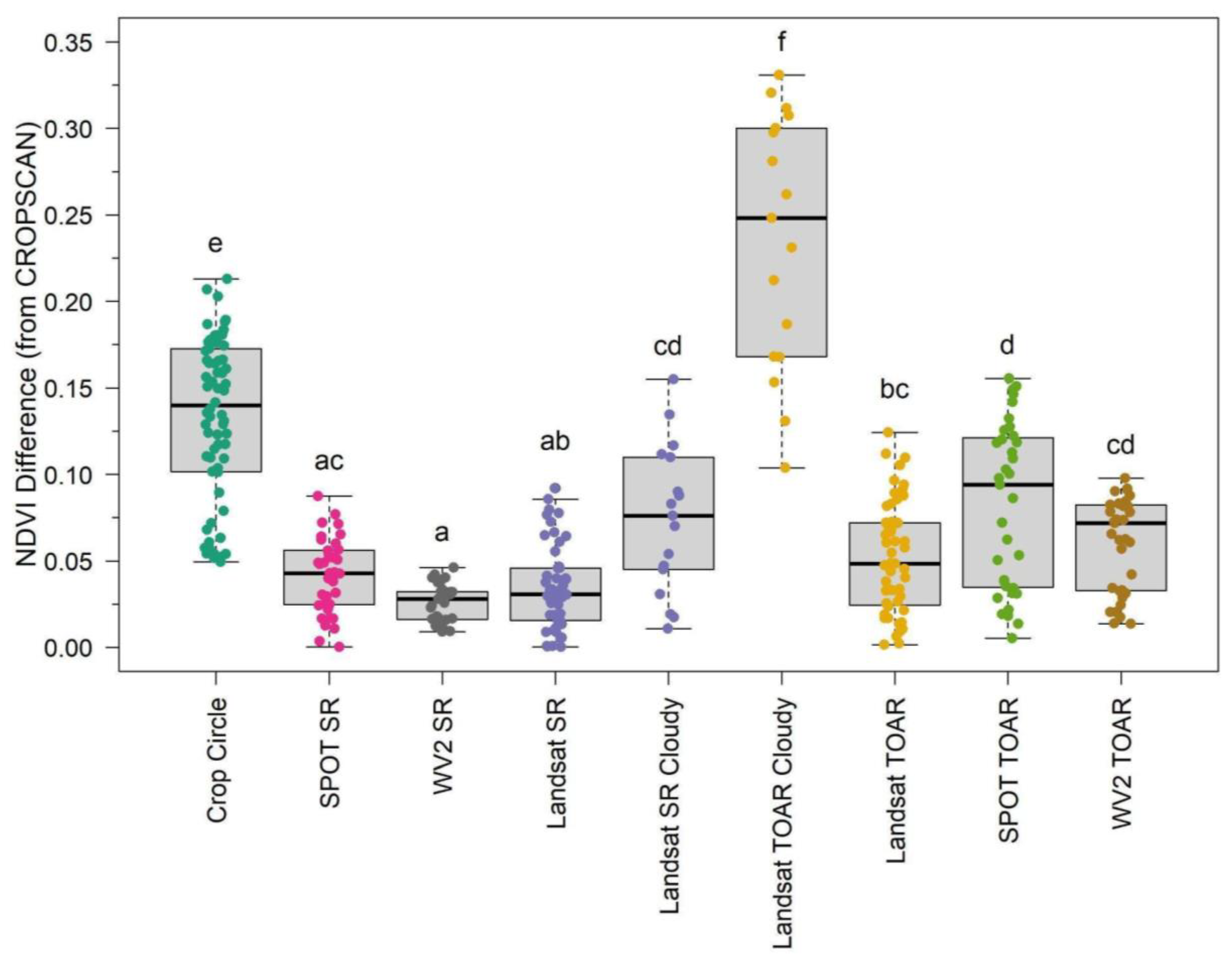
 ) are excluded from reported statistics on the left.
) are excluded from reported statistics on the left.
 ) are excluded from reported statistics on the left.
) are excluded from reported statistics on the left.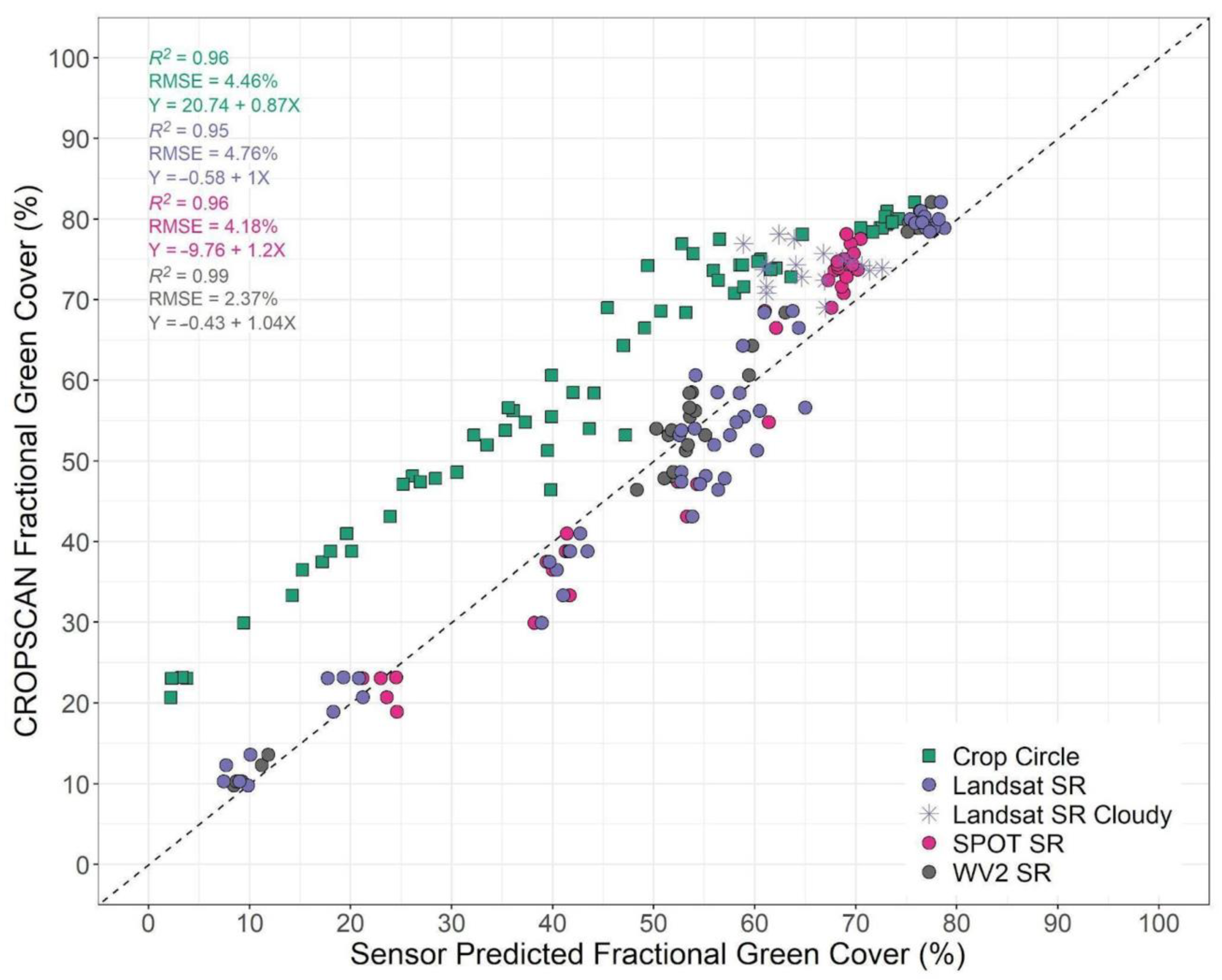
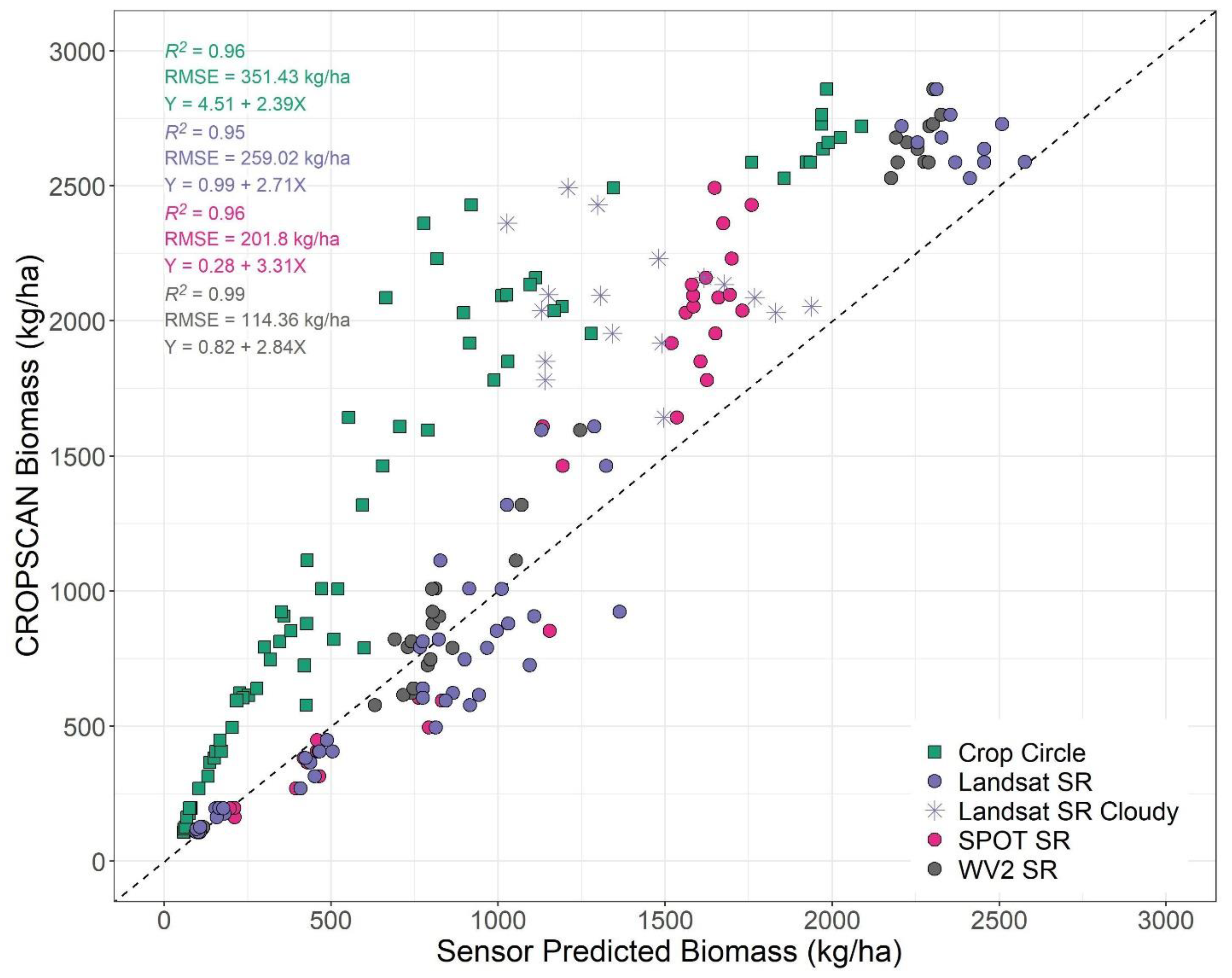
| Sensor | Landsat 7 | WorldView-2 | SPOT 5 | CROPSCAN | Crop Circle | RGB Photos |
|---|---|---|---|---|---|---|
| Swath width (km)/footprint (m2) | 185 km | 16.4 km | 60–80 km | 1 m2 | 0.13 m2 | 2.7 m2 |
| Repeat coverage | 16 days | 1.1–3.7 days | 2–3 days | – | – | – |
| Altitude/Height | 705 km | 770 km | 822 km | 1.8 m | 1 m | 1.7 m |
| Ground resolution | 30 m | 1.84–2.4 m | 10 m | – | – | – |
| Red band | 630–690 nm | 630–690 nm | 610–680 nm | 630–685 nm | 660–680 nm | – |
| NIR band | 770–900 nm | 770–895 nm | 780–890 nm | 845–855 nm | 775–810 nm | – |
| Date T1 | 6 December 2012 | 6 December 2012 | – | 6 December 2012 | 6 December 2012 | 14 December 2012 |
| Start time T1 | 15:42:12.92 | 16:03:02.78 | – | 15:54:23 | 15:16:05.0 | 17:24 |
| End time T1 | 15:42:39.68 | 16:03:04.39 | – | 17:53:41 | 17:27:07.8 | 18:19 |
| Average data points per Landsat pixel T1 | 1 | 15 × 15 | – | 34 | 575 | 3 |
| Date T2 | 23 January 2013 | – | 23 January 2013 | 23 January 2013 | 23 January 2013 | 23 January 2013 |
| Start time T2 | 15:42:24.99 | – | 16:05:05.76 | 15:59:18 | 14:53:17.6 | 16:24 |
| End time T2 | 15:42:51.75 | – | 16:05:43.6 | 17:23:08 | 18:11:21.6 | 18:40 |
| Average data points per Landsat pixel T2 | 1 | – | 3 × 3 | 45 | 325 | 3 |
| Sensors Bands, Date | Slope | Intercept | adj. R2 | RMSE |
|---|---|---|---|---|
| CROPSCAN vs. Landsat 7 SR | ||||
| Red, 6 December & 23 January | 1.199 | −0.004 | 0.898 | 0.011 |
| NIR, 6 December & 23 January | 1.141 | −0.005 | 0.935 | 0.034 |
| NDVI, 6 December & 23 January | 0.997 | −0.004 | 0.952 | 0.041 |
| CROPSCAN vs. WorldView-2 SR | ||||
| Red, 6 December | 1.080 | −0.012 | 0.952 | 0.008 |
| NIR, 6 December | 1.069 | −0.019 | 0.951 | 0.030 |
| NDVI, 6 December | 1.043 | −0.012 | 0.988 | 0.020 |
| CROPSCAN vs. SPOT 5 SR | ||||
| Red, 23 January | 1.674 | −0.038 | 0.917 | 0.010 |
| NIR, 23 January | 1.200 | −0.004 | 0.925 | 0.031 |
| NDVI, 23 January | 1.197 | −0.121 | 0.959 | 0.036 |
| CROPSCAN vs. Crop Circle | ||||
| Red, 6 December & 23 January | 0.659 | 0.018 | 0.804 | 0.015 |
| NIR, 6 December & 23 January | 2.601 | −0.386 | 0.770 | 0.061 |
| NDVI, 6 December & 23 January | 0.870 | 0.203 | 0.956 | 0.038 |
| Crop Circle vs. Landsat 7 SR | ||||
| Red, 6 December & 23 January | 1.771 | −0.035 | 0.888 | 0.017 |
| NIR, 6 December & 23 January | 0.344 | 0.180 | 0.866 | 0.015 |
| NDVI, 6 December & 23 January | 1.130 | −0.218 | 0.899 | 0.069 |
| Crop Circle vs. WorldView-2 SR | ||||
| Red, 6 December | 1.522 | −0.043 | 0.919 | 0.140 |
| NIR, 6 December | 0.340 | 0.166 | 0.918 | 0.013 |
| NDVI, 6 December | 1.159 | −0.198 | 0.943 | 0.051 |
| Crop Circle vs. SPOT 5 SR | ||||
| Red, 23 January | 1.880 | −0.028 | 0.739 | 0.021 |
| NIR, 23 January | 0.407 | 0.177 | 0.759 | 0.021 |
| NDVI, 23 January | 1.281 | −0.333 | 0.931 | 0.050 |
| Landsat 7 SR vs. WorldView-2 SR | ||||
| Red, 6 December | 0.867 | −0.002 | 0.959 | 0.006 |
| NIR, 6 December | 0.917 | −0.007 | 0.971 | 0.020 |
| NDVI, 6 December | 1.019 | 0.004 | 0.977 | 0.028 |
| Landsat 7 SR vs. SPOT 5 SR | ||||
| Red, 23 January | 1.099 | −0.001 | 0.960 | 0.004 |
| NIR, 23 January | 1.189 | −0.032 | 0.976 | 0.009 |
| NDVI, 23 January | 1.119 | −0.071 | 0.984 | 0.016 |
| Sensors Bands, Date | Slope | Intercept | adj. R2 | RMSE |
|---|---|---|---|---|
| CROPSCAN vs. Landsat 7 TOAR | ||||
| Red, 6 December & 23 January | 1.415 | −0.038 | 0.895 | 0.011 |
| NIR, 6 December & 23 January | 1.203 | −0.012 | 0.936 | 0.034 |
| NDVI, 6 December & 23 January | 1.053 | 0.012 | 0.950 | 0.041 |
| CROPSCAN vs. WorldView-2 TOAR | ||||
| Red, 6 December | 2.603 | −0.042 | 0.951 | 0.008 |
| NIR, 6 December | 2.323 | −0.025 | 0.951 | 0.030 |
| NDVI, 6 December | 1.099 | −0.001 | 0.988 | 0.020 |
| CROPSCAN vs. SPOT 5 TOAR | ||||
| Red, 23 January | 2.042 | −0.096 | 0.916 | 0.010 |
| NIR, 23 January | 1.298 | −0.017 | 0.925 | 0.031 |
| NDVI, 23 January | 1.261 | −0.074 | 0.954 | 0.037 |
| Crop Circle vs. Landsat 7 TOAR | ||||
| Red, 6 December & 23 January | 2.087 | −0.085 | 0.884 | 0.017 |
| NIR, 6 December & 23 January | 0.363 | 0.178 | 0.868 | 0.015 |
| NDVI, 6 December & 23 January | 1.198 | −0.202 | 0.905 | 0.067 |
| Crop Circle vs. WorldView-2 TOAR | ||||
| Red, 6 December | 3.672 | −0.086 | 0.920 | 0.014 |
| NIR, 6 December | 0.741 | 0.164 | 0.920 | 0.012 |
| NDVI, 6 December | 1.225 | −0.188 | 0.948 | 0.049 |
| Crop Circle vs. SPOT 5 TOAR | ||||
| Red, 23 January | 2.293 | −0.093 | 0.739 | 0.021 |
| NIR, 23 January | 0.440 | 0.172 | 0.759 | 0.021 |
| NDVI, 23 January | 1.359 | −0.288 | 0.941 | 0.046 |
| Landsat 7 TOAR vs. WorldView-2 TOAR | ||||
| Red, 6 December | 1.793 | 0.000 | 0.960 | 0.005 |
| NIR, 6 December | 1.887 | −0.004 | 0.971 | 0.019 |
| NDVI, 6 December | 1.016 | −0.001 | 0.978 | 0.026 |
| Landsat 7 TOAR vs. SPOT 5 TOAR | ||||
| Red, 23 January | 1.111 | 0.055 | 0.959 | 0.003 |
| NIR, 23 January | 1.205 | −0.034 | 0.976 | 0.009 |
| NDVI, 23 January | 1.131 | −0.049 | 0.987 | 0.013 |
Disclaimer/Publisher’s Note: The statements, opinions and data contained in all publications are solely those of the individual author(s) and contributor(s) and not of MDPI and/or the editor(s). MDPI and/or the editor(s) disclaim responsibility for any injury to people or property resulting from any ideas, methods, instructions or products referred to in the content. |
© 2024 by the authors. Licensee MDPI, Basel, Switzerland. This article is an open access article distributed under the terms and conditions of the Creative Commons Attribution (CC BY) license (https://creativecommons.org/licenses/by/4.0/).
Share and Cite
Thieme, A.; Prabhakara, K.; Jennewein, J.; Lamb, B.T.; McCarty, G.W.; Hively, W.D. Intercomparison of Same-Day Remote Sensing Data for Measuring Winter Cover Crop Biophysical Traits. Sensors 2024, 24, 2339. https://doi.org/10.3390/s24072339
Thieme A, Prabhakara K, Jennewein J, Lamb BT, McCarty GW, Hively WD. Intercomparison of Same-Day Remote Sensing Data for Measuring Winter Cover Crop Biophysical Traits. Sensors. 2024; 24(7):2339. https://doi.org/10.3390/s24072339
Chicago/Turabian StyleThieme, Alison, Kusuma Prabhakara, Jyoti Jennewein, Brian T. Lamb, Greg W. McCarty, and Wells Dean Hively. 2024. "Intercomparison of Same-Day Remote Sensing Data for Measuring Winter Cover Crop Biophysical Traits" Sensors 24, no. 7: 2339. https://doi.org/10.3390/s24072339






